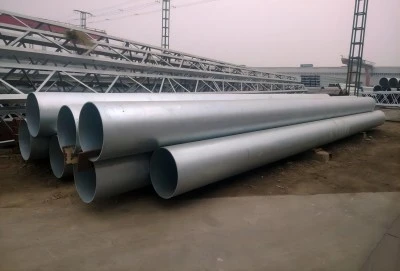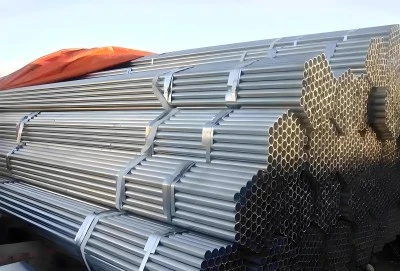Galvanized mild steel pipes are a popular choice for various applications due to their durability, corrosion resistance, and cost-effectiveness. However, to ensure their longevity and optimal performance, proper maintenance is crucial. In this comprehensive guide, we'll explore essential maintenance tips, corrosion prevention techniques, and when it's time to replace your galvanized steel pipes. Whether you're a homeowner or a professional contractor, these insights will help you maximize the lifespan of your pipe installations.
|
|
|
Essential Maintenance Tips for Long-Lasting Steel Pipes
Maintaining your galvanized mild steel pipes is key to ensuring their longevity and performance. Here are some essential tips to keep your pipes in top condition:
Regular Inspections
Conduct routine visual inspections of your pipe installations. Look for signs of wear, damage, or corrosion. Pay special attention to joints, bends, and areas exposed to moisture or chemicals. Early detection of issues can prevent more significant problems down the line.
Cleaning
Regularly clean your pipes to remove debris, dust, and other contaminants that can accumulate over time. Use a soft brush or cloth with mild soap and water for general cleaning. Avoid using harsh chemicals or abrasive materials that could damage the galvanized coating.
Proper Drainage
Ensure that your pipes have proper drainage to prevent water accumulation. Standing water can accelerate corrosion and lead to pipe failure. Install appropriate slopes and drainage systems to keep water flowing smoothly.
Temperature Control
Protect your pipes from extreme temperature fluctuations. Sudden changes in temperature can cause pipes to expand or contract, leading to stress and potential damage. Insulate pipes in areas prone to temperature swings, such as attics or crawl spaces.
Pressure Management
Monitor and maintain appropriate pressure levels in your pipe system. Excessive pressure can strain pipes and joints, potentially leading to leaks or bursts. Install pressure regulators if necessary to keep pressure within recommended limits.
Avoid Chemical Exposure
Minimize exposure to harsh chemicals that can deteriorate the galvanized coating. If chemical exposure is unavoidable, consider using protective coatings or selecting alternative pipe materials for those specific areas.
Professional Maintenance
Schedule regular professional maintenance checks. Experienced technicians can identify potential issues that may not be visible to the untrained eye and provide specialized cleaning or repair services when needed.
How to Prevent Corrosion in Galvanized Steel Pipes
Corrosion is one of the primary concerns when it comes to galvanized mild steel pipes. While the galvanization process provides a protective zinc coating, additional measures can be taken to prevent corrosion and extend the life of your pipes:
Cathodic Protection
Implement cathodic protection systems to prevent corrosion in underground or submerged pipes. This method uses sacrificial anodes or impressed current to protect the metal surface from oxidation.
Protective Coatings
Apply additional protective coatings to enhance corrosion resistance. Epoxy coatings, polyurethane, or specialized anti-corrosion paints can provide an extra layer of protection, especially in harsh environments.
Moisture Control
Minimize moisture exposure by ensuring proper insulation and ventilation. Use dehumidifiers in damp areas and fix any leaks promptly to prevent water accumulation around pipes.
pH Balance
Monitor and maintain the pH balance of fluids flowing through the pipes. Highly acidic or alkaline substances can accelerate corrosion. Use pH neutralizers or treatment systems when necessary.
Avoid Galvanic Corrosion
Prevent contact between dissimilar metals to avoid galvanic corrosion. Use appropriate isolation techniques, such as dielectric unions or insulating gaskets, when connecting galvanized steel pipes to other metal components.
Regular Cleaning and Inspection
Implement a regular cleaning and inspection schedule to remove corrosive substances and identify early signs of corrosion. This proactive approach can help prevent minor issues from escalating into major problems.
Water Treatment
If your pipes are used for water supply, consider implementing water treatment systems to remove corrosive elements. Softeners, filters, and chemical treatments can help maintain water quality and reduce the risk of internal corrosion.
When to Replace Your Galvanized Steel Pipes
While proper maintenance can significantly extend the life of your galvanized steel pipes, there comes a time when replacement becomes necessary. Here are some indicators that it may be time to replace your pipes:
Age of the Pipes
Galvanized steel pipes typically have a lifespan of 40 to 50 years. If your pipes are approaching or exceeding this age range, it's wise to consider replacement, even if they haven't shown significant signs of deterioration.
Frequent Leaks
If you're experiencing recurring leaks or have had to repair multiple sections of your piping system, it may be more cost-effective to replace the entire system rather than continuing with piecemeal repairs.
Discolored Water
Rusty or discolored water can indicate that the galvanized coating has worn away, exposing the underlying steel to corrosion. This not only affects water quality but can also lead to pipe failure.
Reduced Water Pressure
A gradual decrease in water pressure throughout your system could be a sign of internal corrosion and buildup within the pipes. This restriction can significantly impact the functionality of your plumbing system.
Visible Corrosion
If you can see visible signs of corrosion, such as rust spots, pitting, or flaking on the exterior of the pipes, it's likely that the internal condition is even worse. This is a clear indication that replacement is needed.
Changes in Water Quality
If you notice changes in the taste, odor, or appearance of your water, it could be due to contaminants leaching from corroding pipes. This is not only a plumbing issue but also a potential health concern.
Cost of Repairs
When the cost and frequency of repairs start to outweigh the cost of replacement, it's time to consider a full system upgrade. This can often result in long-term savings and improved performance.
Modernization and Efficiency
Upgrading to newer pipe materials can offer benefits such as improved flow rates, better corrosion resistance, and compliance with current building codes and regulations.
Maintaining your galvanized mild steel pipe installations requires diligence and attention to detail. By following these maintenance tips, implementing corrosion prevention strategies, and knowing when it's time for replacement, you can ensure the longevity and reliability of your piping system. Regular care and timely interventions not only extend the life of your pipes but also contribute to better overall performance and cost savings in the long run.
At Hebei Longma Group Limited (LONGMA GROUP), we understand the importance of quality pipe installations and proper maintenance. As one of China's leading ERW/LSAW steel pipe manufacturers since 2003, we offer a wide range of high-quality steel pipe products to meet your specific needs. Our expertise in producing large-diameter, thick-walled, double-sided, sub-arc-seam welding steel pipes ensures that you have access to durable and reliable piping solutions.
For more information on our products or expert advice on maintaining your galvanized mild steel pipe installations, don't hesitate to reach out to us. Our team of professionals is ready to assist you in making informed decisions about your piping systems.
Call to Action: Have questions about galvanized mild steel pipes or need assistance with your pipe installations? Contact our expert team at info@longma-group.com. We're here to help you maximize the performance and longevity of your piping systems.














